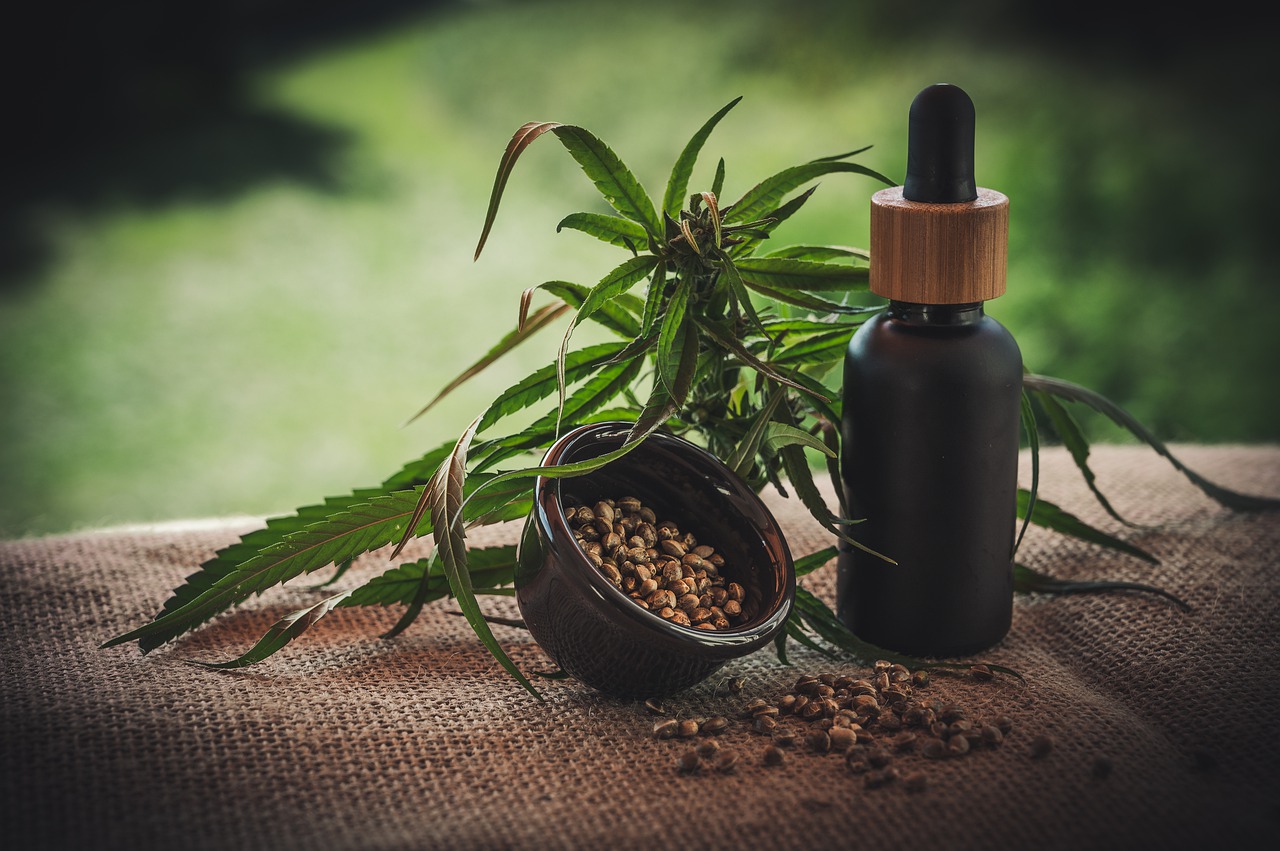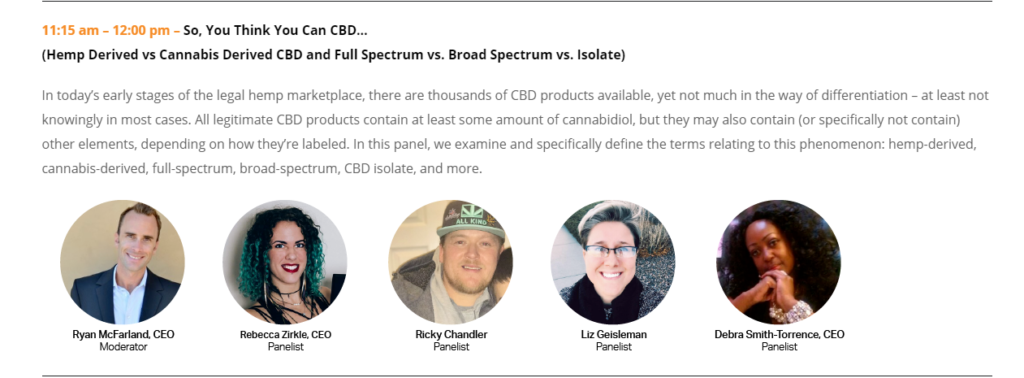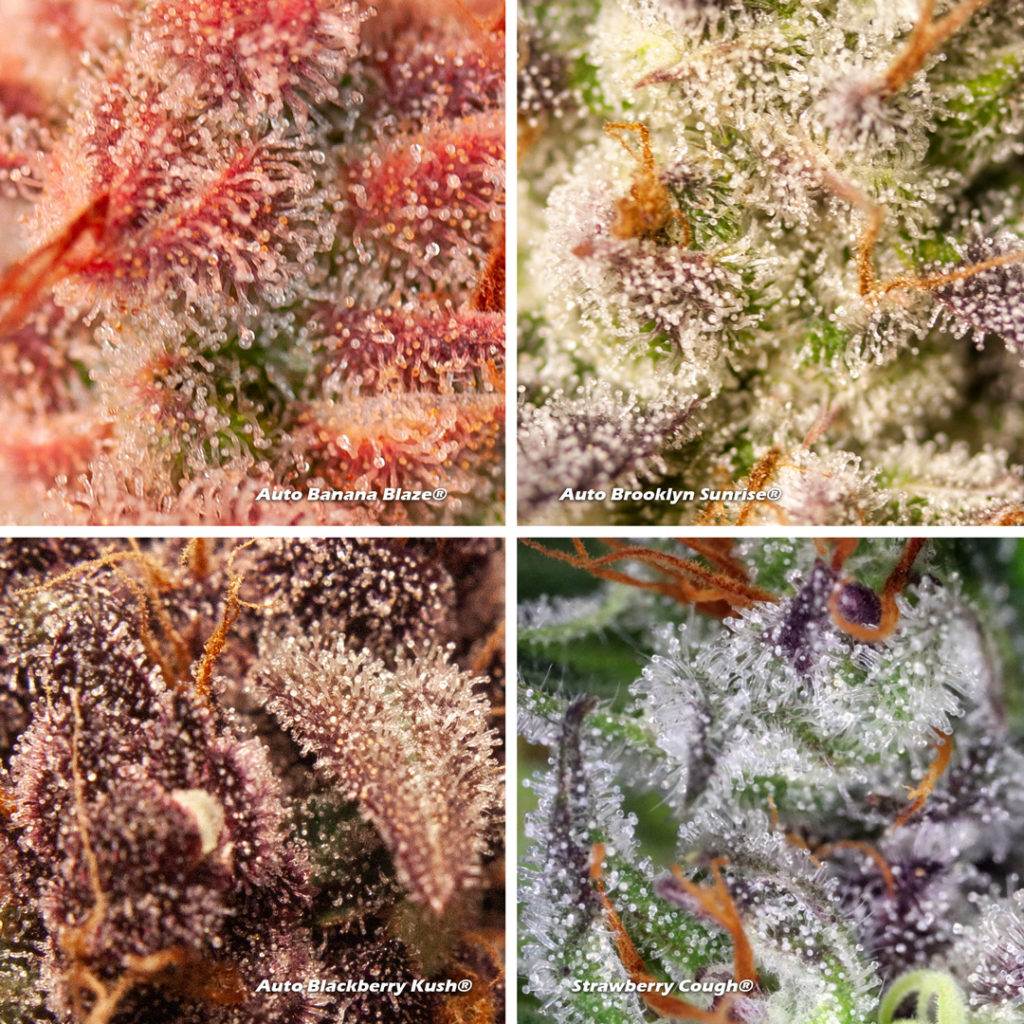
On Friday Liz Geisleman spoke on the panel So You Think You Can CBD… (Hemp Derived vs. Cannabis Derived CBD and Full Spectrum vs. Broad Spectrum vs. Isolate) with moderator Ryan McFarland CEO of WhereZHemp, along with Rebecca Zirkle CEO of Cultivate Hope Chemovar, Debra Smith-Torrence CEO of Auspicious Wellness and Ricky Chandler aka Ricochet. The panel provided strong background and information into the difference between Hemp Derived and Cannabis Derived CBD.

The Basics
If you already have a strong understanding feel free to skip ahead. If not here is some basic terminology that might help for a better understanding.
CBD is the abbreviation of cannabidiol which is one of the 100+ cannabinoids that develop in the resin glands (or trichomes) in the cannabis plant.
THC stands for delta-9-tetrahydrocannabinol the cannabinoid molecule, and the main psychoactive ingredient in marijuana. (Notice the nine! Important for later).
CBD and THC are phyto-cannabinoids aka they come from the cannabis plant.) More specifically they come from the trichomes. Trichomes are the small, little sticky alien looking bodies that extend from plants (including cannabis) as well as many other plants such as lichens, alge, basil, etc. (Dutch Passion Seed Company)

“The most simple Phyto cannabinoid definition is any cannabinoid produced in the trichomes of a cannabis plant. When extracted from the plant and consumed, Phyto cannabinoids interact with our body’s receptors to produce numerous psychotropic and therapeutic effects. Both plants and animals produce their own cannabinoids.” Weedmaps.com
As stated phyto-cannabinoids interact with our body’s receptors in our own endo cannabinoid system (endo meaning inside the body). Essentially the two mesh really well and can help us feel better. (Read more about the interactions with endocannabinoid system here.)
Different phyto-cannabinoids interact with our endocannabinoid system to do different things. For example CBD is known to help people with inflammatory issues, pain reduction, sleep aid and much more. Other plants produce cannabinoids and terpenes but most can be found in cannabis and at a higher concentration.
Terpenes and Flavonoids
This is especially true in terpenes. “Terpenes are compounds responsible for the aroma and flavors of cannabis, and support cannabinoids in producing desired effects. Flavonoids are similar to terpenes in that they contribute to a plant’s aroma and flavor profile, but may offer their own unique therapeutic effects.” WeedMaps.com.
A terpene found in mangos (myrcene) or a cannabis terpene are structurally the same. Terpenes also have different ways they interact with the body, check the wheel below. If you have more interest in terpenes be sure to visit our founding member Extract Consultants for more information!

Flavonoids need to have a place in the terpene conversation going forward as well. This is because the natural compounds in terpenes are also in flavonoids. However, flavonoids contain antioxidants and influence color, as well as taste and smell. While also having natural benefits just like terpenes do. For example it is said that Cannaflavin A works just as well as an aspirin, and the added benefit of being a natural component and not synthetically made.
Hemp vs. Cannabis
Now that we have the basics down we can start to discuss Hemp-Derived vs. Cannabis-Derived CBD. The essential difference is the amount of THC the plant contains. Hemp is a variety of the C.Sativa marijuana plant and is federally legal across the US Farm Bill 2018 because it contains 0.3% THC or less. Cannabis (or marijuana)-derived CBD is legal under certain states that generally at the very least allow medical marijuana as well. The main difference is legal standing and what your state laws allow you to use.
This then leads into the conversation of full spectrum, broad spectrum and isolate.
Full spectrum means that your CBD oil contains several naturally occurring cannabis extracts including terpenes, other cannabinoids and up to 0.3% THC.
Broad spectrum contains several plant compounds and cannabinoids but is entirely free from THC.
While isolate is a pure form of CBD or an other cannabinoid containing no other plant compounds. It really depends on what your end product is. What are your customers wanting to get out of your product and what do you need it to do?
Many are also discussing the Entourage Effect. Which is the theory that CBD is more effective when ingested with other cannabinoids at the same time (full spectrum). Using the whole hemp plant means it contains all naturally occurring cannabinoids along with trace amounts of THC for a whole experience and aiding the entire body not just one specific ailment.
Delta 8
The panel then discussed Delta 8 (D8). Remember delta-9-tetrahydrocannabinol (THC) mentioned before? D8 is simply delta-8-tetrahydrocannabinol which has similar psychoactive effects as D9.
D8 can be extracted from hemp or marijuana (hemp is federally legal) and has almost an identical chemical structure to D9 with the only difference of the double bond being placed on the eighth carbon and not the ninth.
Panelist Rebecca Zirkle noted that D8 drastically revived the CBD market as D8 can be extracted from hemp. However, commenting it is still a largely unresearched frontier.
Many on the panel commented on how they worry the cannabinoid is fleeting and that regulation will start up soon especially with its relation to the Farm Bill. Noting that synthetically derived compounds remain a scheduled 1 substance by the DEA.
The panel emphasized the importance of having your products 3rd party tested. Throughout the whole supply chain of plant to product it is essential to understand where your supplies are coming from and that they are of high quality. Checking for a CofA (Certification of Analysis), having a lot number, phone number and QR code are just a few of the indicators to check for. Ensuring you are making a safe and high-quality product for your customer.
Thank you to all of the panelists for their insights and advice! If you are curious about any of the topics discussed feel free to reach out to us at TheCannaConsortium to answer any other questions you might have.
Works Cited
Alger, Bradley E. “Getting High on the Endocannabinoid System.” Cerebrum : the Dana Forum on Brain Science, The Dana Foundation, 1 Nov. 2013, www.ncbi.nlm.nih.gov/pmc/articles/PMC3997295/#:~:text=Endocannabinoids and their receptors are,bridge between body and mind.
Dabber, Dr. “Infographic: How Do Cannabis Terpenes Affect the Body?” Leafly, 28 July 2020, www.leafly.com/news/cannabis-101/infographic-what-are-cannabis-terpenes-and-how-do-they-affect-you.
“Farm Bill.” USDA, www.usda.gov/farmbill.
Talley, Dr. Jordan. “CBD & The Entourage Effect – The Commonly Asked Questions.” Spero CBD, 30 Nov. 2020, www.sperocbd.com/resources/cbd-the-entourage-effect-the-ultimate-guide/#:~:text=The entourage effect is a,cannabinoids at the same time.
“Trichomes: How Cannabinoids Are Created.” Weedmaps, 4 Feb. 2021, weedmaps.com/learn/the-plant/how-cannabinoids-terpenes-flavonoids-are-made#:~:text=Terpenes are compounds responsible for,their own unique therapeutic effects.
“What Are Cannabis Trichomes and How Do They Affect Your Smoke?” Dutch Passion, dutch-passion.com/en/blog/what-are-cannabis-trichomes-and-how-do-they-affect-your-smoke-n986#:~:text=Trichomes are the small, hair,neither animal, plant or fungus.
“What Is a Phytocannabinoid?: Phytocannabinoid Definition by Weedmaps.” Weedmaps, weedmaps.com/learn/dictionary/phytocannabinoid#:~:text=The most simple phytocannabinoid definition,animals produce their own cannabinoids.

Teagan is the Marketing & Communications Manager for 710Spirits® and Rocky Mountain Reagents. While continually learning about the cannabis industry and all the possibilities it has to offer she creates content for The Canna Consortium both for blog posts and social media. Make sure to check out @thecannaconsortium2.0 for all industry updates and news.
